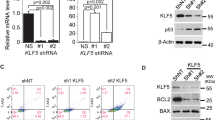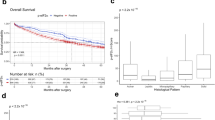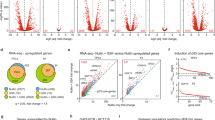Abstract
Most preneoplastic lesions are quiescent and do not progress to form overt tumors. It has been proposed that oncogenic stress activates the DNA damage response and the key tumor suppressor p53, which prohibits tumor growth. However, the molecular pathways by which cells sense a premalignant state in vivo are largely unknown. Here we report that tissue-specific inactivation of the stress signaling kinase MKK7 in KRasG12D-driven lung carcinomas and NeuT-driven mammary tumors markedly accelerates tumor onset and reduces overall survival. Mechanistically, MKK7 acts through the kinases JNK1 and JNK2, and this signaling pathway directly couples oncogenic and genotoxic stress to the stability of p53, which is required for cell cycle arrest and suppression of epithelial cancers. These results show that MKK7 functions as a major tumor suppressor in lung and mammary cancer in mouse and identify MKK7 as a vital molecular sensor to set a cellular anti-cancer barrier.
This is a preview of subscription content, access via your institution
Access options
Subscribe to this journal
Receive 12 print issues and online access
$209.00 per year
only $17.42 per issue
Buy this article
- Purchase on Springer Link
- Instant access to full article PDF
Prices may be subject to local taxes which are calculated during checkout






Similar content being viewed by others

Change history
14 April 2023
A Correction to this paper has been published: https://doi.org/10.1038/s41588-023-01387-x
References
Weston, C.R. & Davis, R.J. The JNK signal transduction pathway. Curr. Opin. Cell Biol. 19, 142–149 (2007).
Wagner, E.F. & Nebreda, A.R. Signal integration by JNK and p38 MAPK pathways in cancer development. Nat. Rev. Cancer 9, 537–549 (2009).
Chen, N. et al. Suppression of skin tumorigenesis in c-Jun NH(2)-terminal kinase-2-deficient mice. Cancer Res. 61, 3908–3912 (2001).
She, Q.B., Chen, N., Bode, A.M., Flavell, R.A. & Dong, Z. Deficiency of c-Jun-NH(2)-terminal kinase-1 in mice enhances skin tumor development by 12-O-tetradecanoylphorbol-13-acetate. Cancer Res. 62, 1343–1348 (2002).
Behrens, A., Jochum, W., Sibilia, M. & Wagner, E.F. Oncogenic transformation by ras and fos is mediated by c-Jun N-terminal phosphorylation. Oncogene 19, 2657–2663 (2000).
Kennedy, N.J. et al. Suppression of Ras-stimulated transformation by the JNK signal transduction pathway. Genes Dev. 17, 629–637 (2003).
Nateri, A.S., Spencer-Dene, B. & Behrens, A. Interaction of phosphorylated c-Jun with TCF4 regulates intestinal cancer development. Nature 437, 281–285 (2005).
Sancho, R. et al. JNK signalling modulates intestinal homeostasis and tumourigenesis in mice. EMBO J. 28, 1843–1854 (2009).
Tournier, C. et al. MKK7 is an essential component of the JNK signal transduction pathway activated by proinflammatory cytokines. Genes Dev. 15, 1419–1426 (2001).
Weston, C.R. et al. The c-Jun NH2-terminal kinase is essential for epidermal growth factor expression during epidermal morphogenesis. Proc. Natl. Acad. Sci. USA 101, 14114–14119 (2004).
Zenz, R. et al. c-Jun regulates eyelid closure and skin tumor development through EGFR signaling. Dev. Cell 4, 879–889 (2003).
Jackson, E.L. et al. Analysis of lung tumor initiation and progression using conditional expression of oncogenic K-ras. Genes Dev. 15, 3243–3248 (2001).
Nikitin, A.Y. et al. Classification of proliferative pulmonary lesions of the mouse: recommendations of the mouse models of human cancers consortium. Cancer Res. 64, 2307–2316 (2004).
Fisher, G.H. et al. Induction and apoptotic regression of lung adenocarcinomas by regulation of a K-Ras transgene in the presence and absence of tumor suppressor genes. Genes Dev. 15, 3249–3262 (2001).
Gorgoulis, V.G. et al. Activation of the DNA damage checkpoint and genomic instability in human precancerous lesions. Nature 434, 907–913 (2005).
Bartkova, J. et al. DNA damage response as a candidate anti-cancer barrier in early human tumorigenesis. Nature 434, 864–870 (2005).
Meek, D.W. Tumour suppression by p53: a role for the DNA damage response? Nat. Rev. Cancer 9, 714–723 (2009).
Collado, M. et al. Tumour biology: senescence in premalignant tumours. Nature 436, 642 (2005).
Bartkova, J. et al. Oncogene-induced senescence is part of the tumorigenesis barrier imposed by DNA damage checkpoints. Nature 444, 633–637 (2006).
Di Micco, R. et al. Oncogene-induced senescence is a DNA damage response triggered by DNA hyper-replication. Nature 444, 638–642 (2006).
Guerra, C. et al. Tumor induction by an endogenous K-ras oncogene is highly dependent on cellular context. Cancer Cell 4, 111–120 (2003).
Efeyan, A. et al. Limited role of murine ATM in oncogene-induced senescence and p53-dependent tumor suppression. PLoS ONE 4, e5475 (2009).
Ding, L. et al. Somatic mutations affect key pathways in lung adenocarcinoma. Nature 455, 1069–1075 (2008).
Zhang, Z. et al. Wildtype Kras2 can inhibit lung carcinogenesis in mice. Nat. Genet. 29, 25–33 (2001).
Lehman, T.A. et al. p53 mutations, ras mutations, and p53-heat shock 70 protein complexes in human lung carcinoma cell lines. Cancer Res. 51, 4090–4096 (1991).
Aas, T. et al. Specific P53 mutations are associated with de novo resistance to doxorubicin in breast cancer patients. Nat. Med. 2, 811–814 (1996).
Fuchs, S.Y. et al. JNK targets p53 ubiquitination and degradation in nonstressed cells. Genes Dev. 12, 2658–2663 (1998).
Das, M. et al. Suppression of p53-dependent senescence by the JNK signal transduction pathway. Proc. Natl. Acad. Sci. USA 104, 15759–15764 (2007).
Schreiber, M. et al. Control of cell cycle progression by c-Jun is p53 dependent. Genes Dev. 13, 607–619 (1999).
Eferl, R. et al. Liver tumor development. c-Jun antagonizes the proapoptotic activity of p53. Cell 112, 181–192 (2003).
Hu, M.C., Qiu, W.R. & Wang, Y.P. JNK1, JNK2 and JNK3 are p53 N-terminal serine 34 kinases. Oncogene 15, 2277–2287 (1997).
Buschmann, T. et al. Jun NH2-terminal kinase phosphorylation of p53 on Thr-81 is important for p53 stabilization and transcriptional activities in response to stress. Mol. Cell. Biol. 21, 2743–2754 (2001).
Oleinik, N.V., Krupenko, N.I. & Krupenko, S.A. Cooperation between JNK1 and JNK2 in activation of p53 apoptotic pathway. Oncogene 26, 7222–7230 (2007).
Jackson, E.L. et al. The differential effects of mutant p53 alleles on advanced murine lung cancer. Cancer Res. 65, 10280–10288 (2005).
Ji, H. et al. LKB1 modulates lung cancer differentiation and metastasis. Nature 448, 807–810 (2007).
Herbst, R.S., Heymach, J.V. & Lippman, S.M. Lung cancer. N. Engl. J. Med. 359, 1367–1380 (2008).
Costa, A. & Zanini, V. Precancerous lesions of the breast. Nat. Clin. Pract. Oncol. 5, 700–704 (2008).
Zhou, Y. et al. Chimeric mouse tumor models reveal differences in pathway activation between ERBB family- and KRAS-dependent lung adenocarcinomas. Nat. Biotechnol. 28, 71–78 (2010).
Kissil, J.L. et al. Requirement for Rac1 in a K-ras induced lung cancer in the mouse. Cancer Res. 67, 8089–8094 (2007).
Young, N.P. & Jacks, T. Tissue-specific p19Arf regulation dictates the response to oncogenic K-ras. Proc. Natl. Acad. Sci. USA 107, 10184–10189 (2010).
Coles, C. et al. p53 mutations in breast cancer. Cancer Res. 52, 5291–5298 (1992).
Boggio, K. et al. Interleukin 12–mediated prevention of spontaneous mammary adenocarcinomas in two lines of Her-2/neu transgenic mice. J. Exp. Med. 188, 589–596 (1998).
Wagner, K.U. et al. Cre-mediated gene deletion in the mammary gland. Nucleic Acids Res. 25, 4323–4330 (1997).
García-Cao, I. et al. “Super p53” mice exhibit enhanced DNA damage response, are tumor resistant and age normally. EMBO J. 21, 6225–6235 (2002).
Sabapathy, K. et al. c-Jun NH2-terminal kinase (JNK)1 and JNK2 have similar and stage-dependent roles in regulating T cell apoptosis and proliferation. J. Exp. Med. 193, 317–328 (2001).
Sabapathy, K. et al. JNK2 is required for efficient T-cell activation and apoptosis but not for normal lymphocyte development. Curr. Biol. 9, 116–125 (1999).
Jacks, T. et al. Tumor spectrum analysis in p53-mutant mice. Curr. Biol. 4, 1–7 (1994).
Kim, N., Odgren, P.R., Kim, D.K., Marks, S.C. Jr. & Choi, Y. Diverse roles of the tumor necrosis factor family member TRANCE in skeletal physiology revealed by TRANCE deficiency and partial rescue by a lymphocyte-expressed TRANCE transgene. Proc. Natl. Acad. Sci. USA 97, 10905–10910 (2000).
Bortnick, A.E. et al. Identification and characterization of rodent ABCA1 in isolated type II pneumocytes. Am. J. Physiol. Lung Cell. Mol. Physiol. 285, L869–L878 (2003).
Fata, J.E. et al. The MAPK(ERK-1,2) pathway integrates distinct and antagonistic signals from TGFalpha and FGF7 in morphogenesis of mouse mammary epithelium. Dev. Biol. 306, 193–207 (2007).
Acknowledgements
We thank all members of our laboratories for discussions; H. Scheuch and M. Radolf for microarray support; and E. Wagner for reading the manuscript. D.S. is supported by the EU INFLA-CARE network. J.M.P. is supported by grants from IMBA, the Austrian Ministry of Sciences, the Austrian Academy of Sciences, GEN-AU (AustroMouse) and an EU ERC Advanced Grant. V.G.G. and A.K. are supported by the EU-grants INFLA-CARE and GENICA.
Author information
Authors and Affiliations
Contributions
D.S. designed and performed most experiments. A.K. and V.G.G. performed the DNA damage and p53 immunohistochemistry and analysis. A.M. performed all RT-PCR analyses. T.W. generated the MKK7 floxed mice. U.E. and V.S. helped with immunohistochemistry. R.-H.Z. analyzed the tumor section as the expert pathologist. J.A.P. and G.G.N. helped in microarray and gene set enrichment analysis. G.F. and M.S. contributed to the characterization of the ErbB-2 and Super p53 transgenic mice, respectively. J.M.P. coordinated the project and wrote the manuscript with D.S.
Corresponding author
Ethics declarations
Competing interests
The authors declare no competing financial interests.
Supplementary information
Supplementary Text and Figures
Supplementary Figures 1–14 and Supplementary Tables 1 and 2. (PDF 2629 kb)
Rights and permissions
About this article
Cite this article
Schramek, D., Kotsinas, A., Meixner, A. et al. The stress kinase MKK7 couples oncogenic stress to p53 stability and tumor suppression. Nat Genet 43, 212–219 (2011). https://doi.org/10.1038/ng.767
Received:
Accepted:
Published:
Issue Date:
DOI: https://doi.org/10.1038/ng.767


